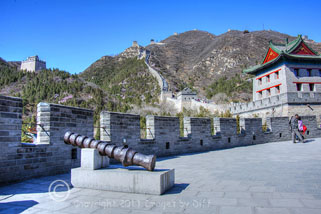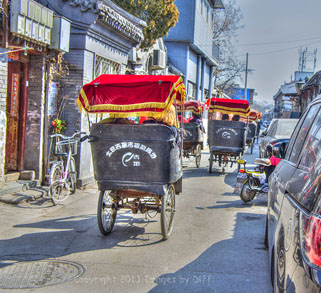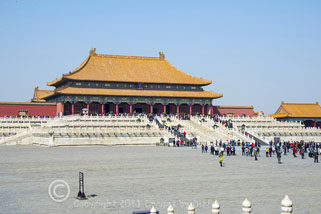Beijing China Day 2&3
|
see more picture here on Flickr |

click photo to enlarge |
Wow the Great Wall of China. What I learned was holy moly is this thing steep…
When I have seen dignitaries at the wall, such as the Obama’s, it looked flat. We
were given 90 minutes to go as far as we wanted or shop at the souvenir shops
or whatever you wanted. So off we went. Karen was smart; she told me to go on
ahead, and she would see me later so I could go as far and fast as I wanted.
Climbing the stairs and looking at all of the bricks used to build this
and knowing it was all done by hand labor was mind-numbing. At different points, I
was grabbed a few times by older Chinese people. At first I thought they
wanted me to take a picture of them, but no, they wanted a picture taken with
their cameras with ME in it.
Our guide explained later that the older generation grew up in a very
closed society and they never thought they would be able to travel in their
own country to see the Great Wall, let alone run into a big nose tourist. So
because of that they wanted a picture to take back home to prove it. Yes, it
seems we westerners are called Big Noses because compared to most Chinese, who
have flat noses, we have big noses. |

click photo to enlarge |
Construction of the Summer Palace began in 1750 as a fancy royal garden for
royal families to rest and entertain. Apparently, being a royal can be very
tiring. It later became the main residence of royal members at the end of
the Qing Dynasty. It was opened to the public in 1924. The largest part of
the summer palace was the lake. After the summer Palace, we went out for a
Beijing or Peking duck dinner, then a Kung Fu show at the Red Theater.
Day three was off to the Houtongs for a Rickshaw tour and a visit to Mr.
Lui the famous cricket fighter trainer, followed by lunch at a home of a
local in the Houtong. The Houtongs are fascinating. They are the older style
homes where houses all abut each other and form a cube. They then have an
inside courtyard. They are being torn down to build high-rises. This was a
wonderful experience and Mr. Liu was truly fun. The homes are only 400 to
500 sq feet and we were told, they sell for about ˝ million US, and they
have no toilets. There are public toilets in the Houtongs, and that’s what
the residents use. |

click photo to enlarge |
From the Houtong, we were off to Tiananmen Square and the Forbidden City.
For me, Tiananmen Square represents the protests of 1989 with tanks in the
square to squash the protests and unwashed masses. The entrance to the
Forbidden City is right off Tiananmen Square and is a rectangle, .6 miles
from north to south and 1/2 Mile from east to west. This was the Imperial
Palace from the Ming Dynasty to the end of the Qing Dynasty from 1368 to
1912. It was the home of 24 emperors – 14 of the Ming dynasty and 10 of the
Qing dynasty. One of the things I learned was an emperor could have one wife
and up to 3,000 concubines. The concubines mostly only saw the emperor once,
and for one fling. They were required to live the rest of their lives in the
Forbidden City, not being allowed to leave. We were told that each morning
each one was required to separately say good morning to the empress. When a
new emperor took over they were expected to commit suicide or be killed. |

click photo to enlarge |

click photo to enlarge |
| |
|
|
|
|
|
|
|
|
|
|
|
|
|




